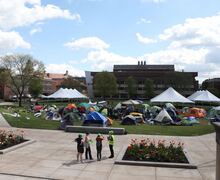Students confused over decreased Google Drive storage
Bridget Overby | Presentation Director
Students storage was decreased from unlimited to 10GB per user.
Get the latest Syracuse news delivered right to your inbox.
Subscribe to our newsletter here.
On Jan. 17, Syracuse University and SUNY ESF students were informed through an email by SU’s Information Technology Services about new storage quotas for the university’s Google Workspace. Students are now limited to 10GB of storage per user and no longer have the ability to create shared drives. The reduction for students took effect on Jan. 3 — 13 days before classes began for the spring semester.
“Users over the quota are presented with a warning and are able to view, export and remove files to bring their My Drive storage consumption under the quota. Users who exceed the storage quota are not able to create, upload or modify files within their My Drive,” the email said.
Previously, SU students and staff had access to unlimited storage in the Google Workspace, but are now limited to 10GB. Faculty and instructors’ storage has been reduced to 60GB, according to the email.
The Daily Orange asked Syracuse University students for their opinion about the new storage quotas.
Overall, SU students from a variety of majors expressed frustration and confusion with the new storage quota. Many said they think the quota will reduce the effectiveness of collaboration with peers and change the way students are able to conduct their academic work, specifically in majors that require large files for their work.
Will Delgado, a sophomore studying business management and television, radio and film, said he mainly uses his university Google Drive to export clips and final versions of his academic work, such as final film projects. The new storage quota may force him to buy more storage himself, “a large burden” considering current SU fees students already face, he said.
“For students like me who are working in some sort of visual art, which is very common across all schools regardless of your major, 10 gigabytes of storage is not by any means suitable without having to further purchase storage on their personal drives or external hard drives that cost over a hundred dollars,” Delgado said.
Sophomore political science and magazine, news and digital journalism student Danielle Blyn said that although she has not been affected by the change yet, she anticipates her group project-based classes will be negatively impacted.
“When we are working with video footage and writing, having the shared drive made everything a lot easier,” Blyn said. “I think it will affect the way students work because it will make sharing information a lot harder, especially for majors that are more visually focused with people having different parts to contribute.”
The storage quota aims to address data proliferation to ensure there is “equitable access to storage for all,” according to ITS. The strategy also aims to “balance and efficiently manage” its digital resources to make academic services and education tools more efficient.
“By adopting this measure, we encourage better data management and organization, fostering a more disciplined approach to digital storage. It’s not just about conserving space; it’s also crucial for maintaining a secure and reliable digital environment conducive to academic pursuits,” according to ITS Answers.
Anna Macchia, a sophomore studying psychology, agreed the quota will make group collaboration projects much more difficult as students using the university’s Google Drive may run into conflicts with peers who have access to more storage.
Gavin MacKinnon, a sophomore, said the amount of work he has as an architecture major for one semester could sum up to 50GB. Without the unlimited storage, he was forced to migrate the files to different places to save his progress.
“We have a lot of group projects and the software that we use, probably like a lot of other majors, has big files,” he said. “It’s hard to share them, so we used the shared drive, but we can’t use them anymore. A single drawing we’d have would be, like, 2GB.”
Unlike students, SU faculty and instructors will continue to have the ability to create and manage shared drives, according to ITS Answers. These shared drives will not count against the individual user’s “My Drive” storage use.
Although Steven Kearney Jr., a senior studying sport management, uses a personal Google Drive account, he is concerned about the restriction that may be placed on professors. If they do not have sufficient access to storage, he said, it may change classroom dynamics.
“If they’re doing it to the faculty as well, then that would affect part of my learning, right?” Kearney said. “It doesn’t seem like there’s a reason for this change.”
According to ITS, when a user exceeds the set storage limit, they will no longer be able to upload new files or images to Google Drive or create new files in “collaborative content creation apps” like Google Docs, Sheets and Slides. Until storage usage is reduced, nobody can edit or copy the affected files.
Applied data science graduate student Yashaswini Kulkarni said she uses Google Colab — a program that allows users to write and use arbitrary python code — to store her work and information with classmates.
“We use Google Colab for a lot of work, and for data science, per se, we write a lot of code and scripts there and without that, there would be a lot of issues,” Kulkarni said.
Additionally, users cannot back up photos or videos to Google Photos or record new meetings in Google Meet. However, they can still sign into and gain access to their account, view and download their files, and send and receive emails.
Khanh Newhill-Leahy, who studies graphic design, said a friend of theirs exceeded the new 10GB storage by over 800% and did not know where to put all of their work. They said it’s troublesome for students in the S.I. Newhouse School of Public Communications as it will “create more issues for students than it will help.”
“I don’t understand why they decided to cut it down from unlimited,” they said. “The Adobe programs take up so much space and I know a lot of people use their Google Drives as one of their backups.”
They said another other option for students would be to buy SSD drives with terabytes of storage, but those can usually exceed hundreds of dollars. Having unlimited storage for free was extremely helpful, they said.
If users are over the storage quotas, ITS recommends they delete or export their data from their university google accounts accounts. The recommended option to switch data to another Google account is Google Takeout, Google’s migration tool, according to ITS Answers.
SU users also have access to a default of 500GB in storage through Microsoft OneDrive. Staff and faculty can request more storage from IT support, according to ITS Answers.
“The tool is provided by Google and due to its intricacies is not supported by Syracuse University ITS,” the website said. “SU/ESF students requiring group-based shared drives, for course related activities, should request project space through their course instructor.”
Freshman international relations student Marisa Pileggi said, because of her major, she is in a lot of reading-heavy classes, and without sufficient storage, she may be at a disadvantage.
“I feel that students should be able to have an unlimited amount of the resources that we pay for to come to school here,” Pileggi said. “I think it’s definitely a useful resource and the way that I had no idea, I’m sure a lot of my friends had no idea.”
Published on January 17, 2024 at 11:15 pm
Contact Faith: [email protected]





